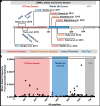The expanding neurological phenotype of DNM1L-related disorders
- PMID: 29529134
- PMCID: PMC11505533
- DOI: 10.1093/brain/awy024
The expanding neurological phenotype of DNM1L-related disorders
Figures

Comment in
-
Reply: The expanding neurological phenotype of DNM1L-related disorders.Brain. 2018 Apr 1;141(4):e29. doi: 10.1093/brain/awy027. Brain. 2018. PMID: 29529130 No abstract available.
Comment on
-
Mutations in DNM1L, as in OPA1, result in dominant optic atrophy despite opposite effects on mitochondrial fusion and fission.Brain. 2017 Oct 1;140(10):2586-2596. doi: 10.1093/brain/awx219. Brain. 2017. PMID: 28969390
References
-
- Gerber S, Charif M, Chevrollier A, Chaumette T, Angebault C, Kane MS, et al. Mutations in DNM1L, as in OPA1, result indominant optic atrophy despite opposite effectson mitochondrial fusion and fission. Brain 2017; 140: 2586–96. - PubMed
Publication types
MeSH terms
Substances
Grants and funding
LinkOut - more resources
Full Text Sources
Other Literature Sources
Miscellaneous

